
DAG ALLAL, TIMBUKTU, MALI: Tuareg men plant grass in the banks of the Niger River to grow a forage crop for their animals and for sale in the markets in the sedentary Tuareg village of Dag Allal in Mali. Unusual amongst Tuareg for their sedentary, non-nomadic existence, these Tuaregs remain in place all year and care for their animals by utilising agricultural techniques. They have received help from the Millenium Village Project which aims to empower local communities through education. They grow rice and forage grass in the nearby Niger river, using a canal and small pump to divert water into ricepaddies. Their leader, El Hadg Agali Ag Mohammoud, 70, explains that reasons of drought, rebellion and a lack of union amongst the Tuareg caused this group to choose to remain in one place, "We live here all year, we take care of our animals by growing the grass that they wouldn't normally have in the hot summer months, other Tuareg don't always understand this, they think that this grass grows naturally. We sometimes have to prevent them taking it, we have to explain that we grow it for our animals and it is not free. Sometimes there is a confrontation as a result, this is not the traditional Tuareg way so we have to explain it to them. I think in the future there will be more Tuareg living this way."(Photo by Brent Stirton/National Geographic.)

LOWARENGAK, TURKANA, KENYA: Images from an internally displaced Turkana community who have been forced off their land by Dassanech tribesman in a conflict over water and grazing rights, Turkana, Kenya. These Turkana now practise fishing as opposed to their traditional pastoralism as their main means of subsistence. The Dassenech have come illegally over the Ethiopian border into Kenya's Turkana. They were pressured by sugar cane farms on the lower Omo river which is the main tributary for Lake Turkana, the largest desert lake in the world. These sugar cane farms robbed the Dassenech of tradional grazing land and water rights and so they moved over the border into Turkana territory and ongoing conflict is the result. This pattern is increasing as Ethiopia's Gibe 3 dam is in full swing. This has reduced the flow of the Omo river to one fifth of its current size, decimating the fertile flood plain in the region and the tribesmen along the Omo now fight for diminishing resources as a result. This conflict continues in Kenya's Turkana region as all around the lake hundreds of thousands of tribespeople will find themselves competing for less and grazing, fishing and clean water sources. A series of droughts have reduced most of these pastoralists to fishing as their chief source of subsistence due to huge cattle and goat deaths. The massively reduced flow of the Omo, source of 90% of Lake Turkana's water, is having a devastating effect on this food and income source. The Ethiopian government has conducted no Environmental Impact Assessment for their dams and has yet to respond to these issues. (Photo by Brent Stirton/Reportage by Getty Images for HRW.)

KISANGANI, DEMOCRATIC REPUBLIC OF CONGO: A portrait of a fisherman stretching before he lowers a large wicker fishing net into the rapids outside the city of Kisangani on the Congo River. Fisherman in this region are commonly affected by Onchocerciasis, commonly known as river blindness, is a filarial disease caused by the parasitic nematode worm Onchocerca volvulus. People are infected by worms transmitted by the bite of blood-sucking blackflies, which breed in fast-flowing rivers. River blindness is not usually fatal, but it inflicts hardship and misery on millions of people. In the human body, the adult worms produce embryonic larvae (microfilariae) that migrate to the skin, eyes and other organs. The worms can cause severe itching, disfiguring skin conditions, and blindness or impaired vision. There are 217.5 million people at risk in Sub-Saharan Africa with 19 million currently infected and 1.15 million who are blind. (Photo by Brent Stirton/Getty Images for GEO magazine.)

INGAL, NIGER: Tuareg Nomads on the move to a place of better grazing and water supply. This group has been in this region for the rainy season, taking advantage of easier water access and good grasses for the animals. The moving is done in stages, usually the Camel herd goes first with a few men, then come the goats and then the rest of the Nomads follow with all their possessions mounted onto donkeys. Tuareg nomad tents are lightweight using wood from the south of Niger, the matting and material which cover them fold down easily. Tuareg Nomads have two traditional priorities, their animals and access to water. This group has moved to this region at this time to enjoy the remaining good grassland of the rainy season and now have to move again to be close to a good water source. (Photo by Brent Stirton/National Geographic.)

KAHAWA, SRI LANKA : The Venerable Dr. Talawe Sangharatana Thero stands in contemplation outside a train wrecked in the Asian Tsunami disaster, Kahawa, Sri Lanka. Over 800 people died in the wreck, many of whom were children. Dr Thero is one of the senior monks for the Southern district of Sri Lanka. Over 70% of Sri Lankans are active practioners of Buddhism and monks have been active in the devastated communites after the impact of the Tsunami. Many have sought shelter in their faith and the monks have offered whatever comfort and shelter they can. (Photo by Brent Stirton/Getty Images)

DJANET, ALGERIA, 3 MAY: Images of a Southern Algerian family picnicking in the desert outside of the town of Djanet on a Friday, the Muslim holy day, on April 3 2009. Djanet is increasingly under threat from the relentless spread of the desert. Climate change has accelerated this phenomenon. (Photo by Brent Stirton/Reportage for Getty Images.)
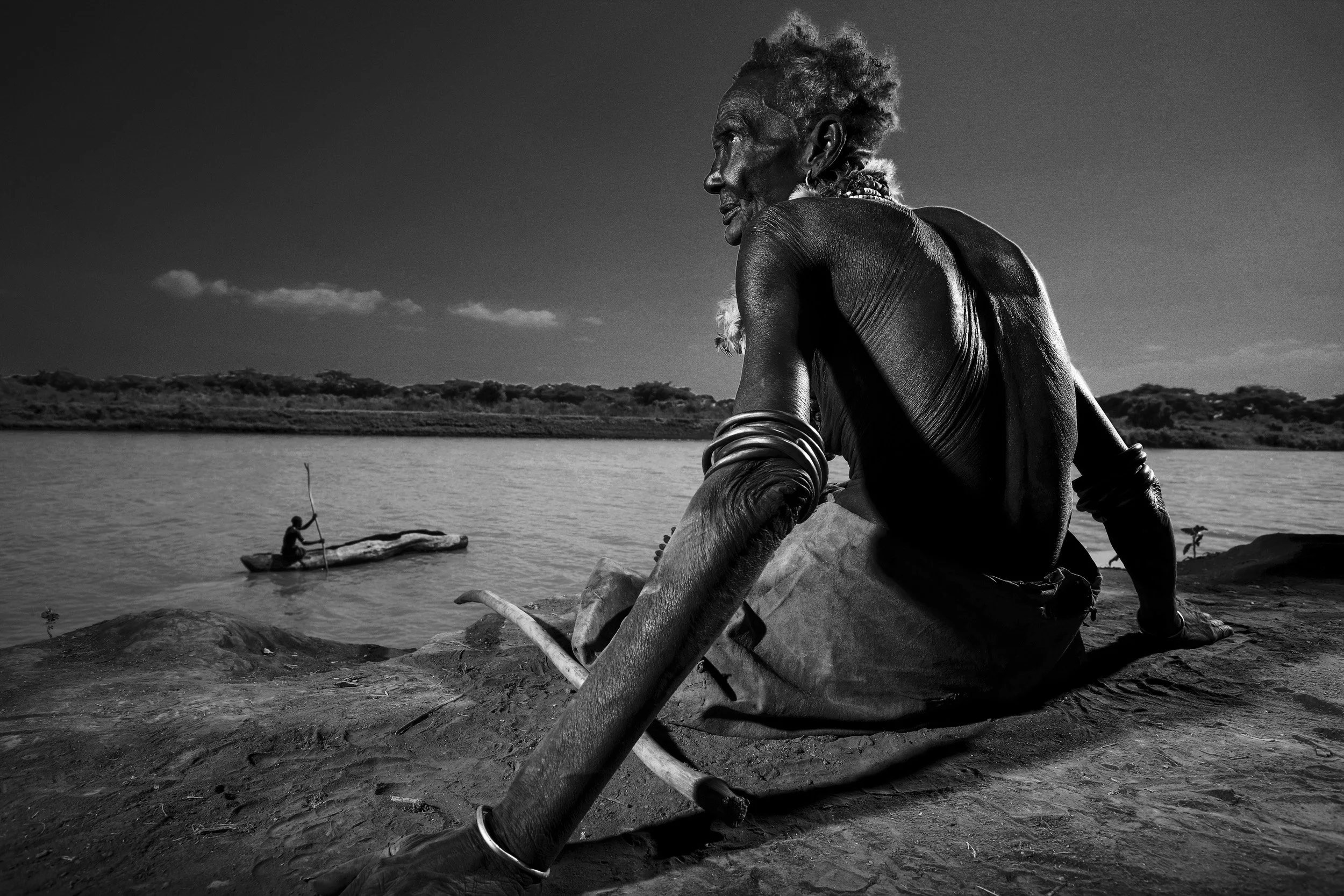
LORYRA, SOUTH OMO, ETHIOPIA, DECEMBER 2007: A elderly Dassanech women sits on the banks of the Omo river in the Lower Omo Valley, South West Ethiopia. Ethiopia has created three large dams and as a result has shrunk the Omo river to one fifth of its size. This has removed the fertile flood plain and greatly reduced grazing for these pastoralists. The Omo is the main tributary for Lake Turkana in Northern Kenya. Overall, over a million tribal people are affected and there are now increasing water and grazing conflicts amongst them. No EIA study was ever done by the Ethiopian government on the effects of their dams on the millions of people downstream. (Photo by Brent Stirton/Getty Images.)

TURKANA, KENYA: Scenes from Longetch fishing village on the shores of Lake Turkana, Kenya, the world's largest inland desert lake. This region of the lake is a well know spawning ground and at the heart of fishing commerce for the Turkana people. These villagers along with many thousands along the shores of this vast body of water are soley dependent on the lake for their survival. These Turkana are traditionally pastoralists but persistent droughts have decimated their herds to such an extent that for many Turkana fishing is now their main means of subsistence and commerce. The same pattern is emerging for other tribes along the lake shore. Recent dam building in Ethiopia has lowered the Omo river to one fifth of its current flow, this is Lake Turkana's largest tributary. Saudi owned sugar cane farms along the banks of the Omo are already causing tribal movement down to Lake Turkana as pastoralists struggle for grazing and water rights. The Omo river supplies 90% of Lake Turkana's water and these dams and sugar cane farms severely impact the renewal of the lake's waters. This threatens all the tribes around the lake and makes conflict over diminishing resources ever likely. (Photo by Brent Stirton/Reportage by Getty Images for Human Rights Watch.)

KURIGRAM, BANGLADESH: Flood-affected village men hack away the embankment left by the most recent flooding in the area where their village used to be. They are doing this on the orders of the local landowner who is using this earth for contruction in another area. These men are effectively further removing the only barrier between them and further flooding but desperately need the small amount they are paid so do the work anyway. The lack of a serious engineering works aimed at flood prevention in Bangladesh is behind the suffering of millions of impoverished rural people. Annual predicable floods bring misery to millions without any effective counter plan. A fatalistic national leadership chooses the displacement of millions rather than try to combat the flooding through engineering ingenuity.
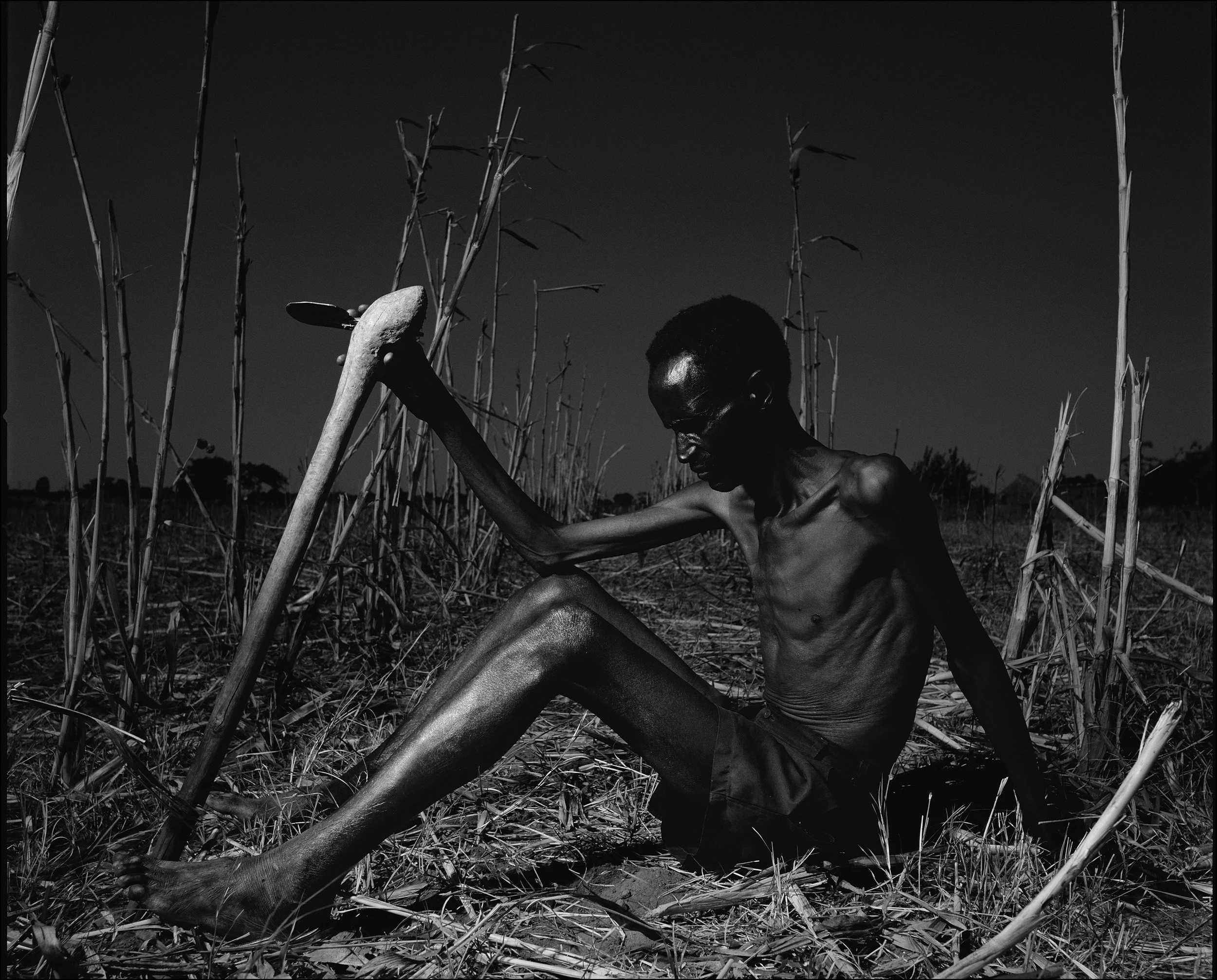
ZAMBIA: A malnourished farmer rests in his fields after harvesting what he could from his failed crop. The worst regional drought in one hundred years has crippled many farmers and starvation is a reality for these rural people. Climate change has brought about unpredicatable rainfall patterns and these impoverished rural farmers bear the brunt of that.

GAIBANDAH, BANGLADESH: Vulnerable farmers on flood damaged islands work to clear rice fields damaged by annual floods which destroy crops and homes amongst the poor on a yearly basis. Bangladesh is one of the worst affected countries in terms of food security. The price of food staples have doubled in the last 5 months and civil unrest is a possibility in the near future. Rising world energy prices, one of the world's poorest populations, and a loss of government subsidies for food staples combined with the world's highest flood plain has meant that many people are down to one meal a day. (Photo by Brent Stirton/Reportage by Getty Images.)

PUKAPUKI, PAPUA NEW GUINEA: A local man showers underneath a waterfall in the rainforest close to his village in the mountains of Papua New Guinea. Traditional ways of life are under threat in Papua as villages have very little means of raising money through which to educate their children and pay medical bills. As a result, villages are selling the timber of the rainforest. This is a non-sustainable practise and is having a devastating effect on water supply, traditional river routes and erosion patterns. Education as to these factors is a vital but lacking components in this transition period for Papua New Guinea. (Photo by Brent Stirton/Reportage by Getty Images.)
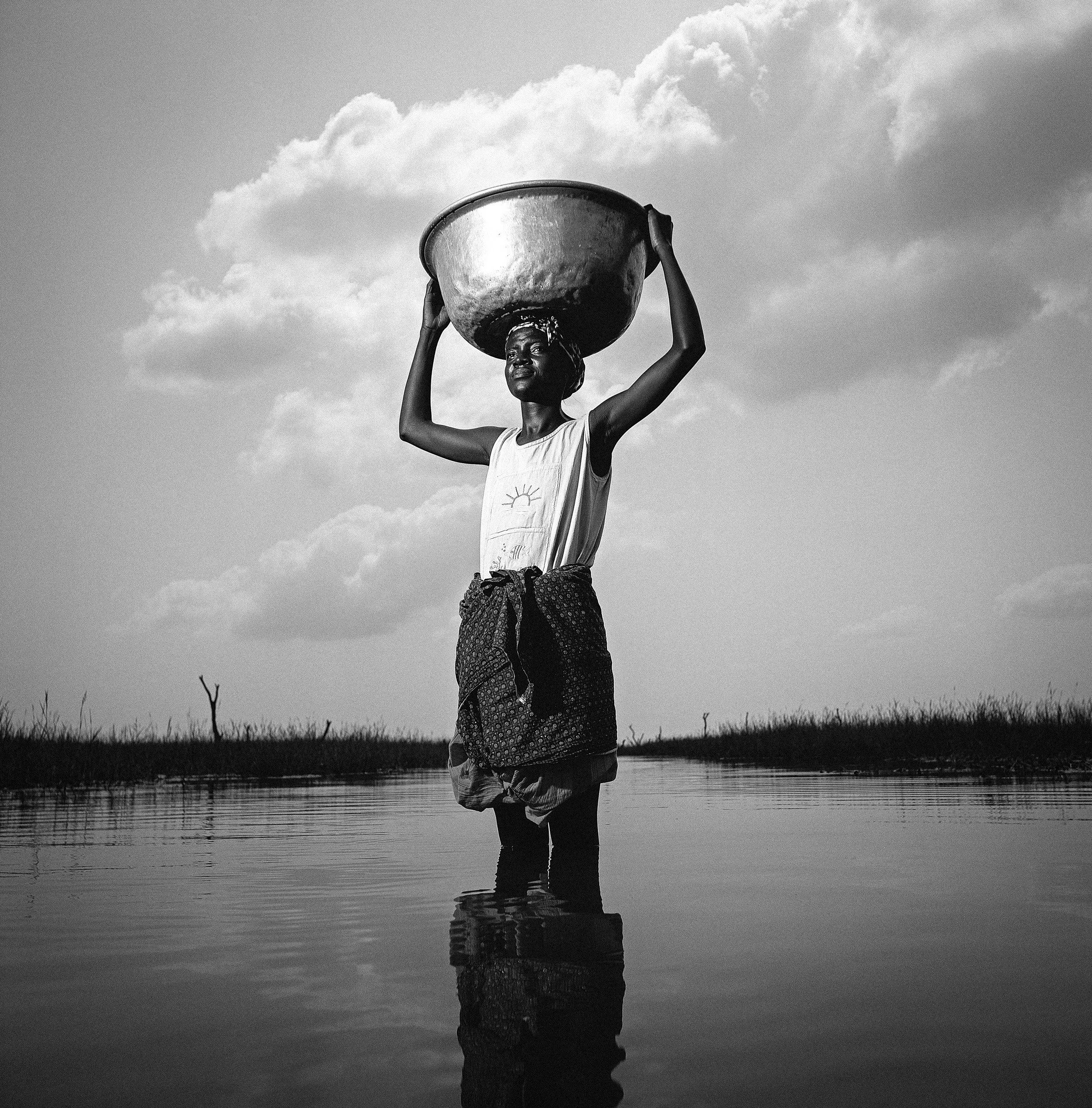
BOLGATANGA, GHANA: A young woman fetches water from a swamp area 4 miles from her village, she makes this trip at least once a day seven days a week. It takes a large part of her day and prevents her from other forms of employment, ongoing education and real participation in village life. Water is a gender issue, with women at the forefront across the majority world. As long as women have to deal with this burden they can never reach their full potential. (Photo by Brent Stirton/Reportage by Getty Images.)

BOLGATANGA, GHANA: A man wearing glasses deeply scrateched over time has in fact been blinded by Trachoma, a preventable disease of the eyes conected to poor hygiene and lack of access to clean water. This is an extremely painful disease in which the eyelashes invert and constantly scratch the eyeball. (PHOTO BY BRENT STIRTON/REPORTAGE BY GETTY IMAGES.)

BALEKE VILLAGE, BENGAMISA DISTRICT, DEMOCRATIC REPUBLIC OF CONGO: Pastor Jerome Gendose Kayana, 57, lost his sight to river blindness in 2000. He saw numerous local traditional doctors but ultimately went blind because of a lack of access to western medicine. Onchocerciasis, commonly known as river blindness, is a filarial disease caused by the parasitic nematode worm Onchocerca volvulus. People are infected by worms transmitted by the bite of blood-sucking blackflies, which breed in fast-flowing rivers. River blindness is not usually fatal, but it inflicts hardship and misery on millions of people. In the human body, the adult worms produce embryonic larvae (microfilariae) that migrate to the skin, eyes and other organs. The worms can cause severe itching, disfiguring skin conditions, and blindness or impaired vision. There are 217.5 million people at risk in Sub-Saharan Africa with 19 million currently infected and 1.15 million who are blind. Jerome says he initially felt suicidal, but his faith helped him to see that this was, “God’s plan for him.” This was a very difficult period, as he had been an avid reader and had only qualified as a priest two months before he lost his sight. Nowadays he actively encourages his congregation to go to Ivermectin distributions, using himself as an example of why this is important. Pastor Jerome condemns other churches who say that this is a western practice and people should only use African medicine. (Photo by Brent Stirton/Getty Images for GEO magazine.)

Kenya: A Masaai elder sits in the remains of his burned out shamba, he has just burned the place down before he moves on. A terrible five year drought has killed most of his cattle and it is traditional to burn down their living area before moving on. This image was taken at the time of the worst drought in the region for the last 100 years.

KOYA, MARSABIT SOUTH, NORTH KENYA: Rendille Morans dig water for goats and camels in a dry river bed.

RIFT VALLEY PROVINCE, KENYA: Images of a massacre site where drought drove Pokot tribesman out of the Rift Valley, their traditional area, they attacked a Samburu village over cattle grazing rights in the north of Kenya at a time of the worst drought in the region for the last 100 years. 25 Samburu men, women and children were killed in the attack, over 50 cattle were shot and over 300 cattle died later in the week from not being able to access grazing land because of the threat of the Pokot. The drought has brought about increasingly deadly conflict between pastoralists as well as conservationists all competing for grazing land. (Photo by Brent Stirton/Reportage by Getty Images.)

TIMBUKTU, SEPTEMBER 2009: Men bathe in the Niger river after unloading goods from a boat in the port of Timbuktu at the apex of the Niger River, Timbuktu is a historical Malian city, a long established centre of learning for Africa. The Niger river is the main river for West Africa and is a vital artery for trade and services. (Photo by Brent Stirton/National Geographic.)

TIMBUKTU, MALI: A Songhai woman walks between temporary settlements on the outskirts of Timbuktu. Traders come from all over this region of Africa to do business in the legendary city. They come during the rainy season so as to have grazing for their animals and leave again when the season is over, heading back to Niger, Mauritania and other regions of the Sahara. (Photo by Brent Stirton/Reportage by Getty Images.)

MARARABA, NIGER: A young boy gets water from a goat-skin in a scene of Berber semi-nomadic life from the small transit town of Mararaba, Niger, September 27 2009. This small town is an intersection point for Agadez and Niamey. The lack of water in the region and the growing desertification sees more and more of the desert nomad groups moving into already crowded cities in the region. (Photo by Brent Stirton/Reportage by Getty Images.)

: TIMBUKTU, MALI: Young boys lounge in the desert sand on the banks of the Libyan-built canal which brings river water to the heart of Timbuktu, Mali. The Canal was restored by the Libyans, who exerted a strong financial influence over the whole region at the time. (PHOTO BY BRENT STIRTON/NATIONAL GEOGRAPHIC.)
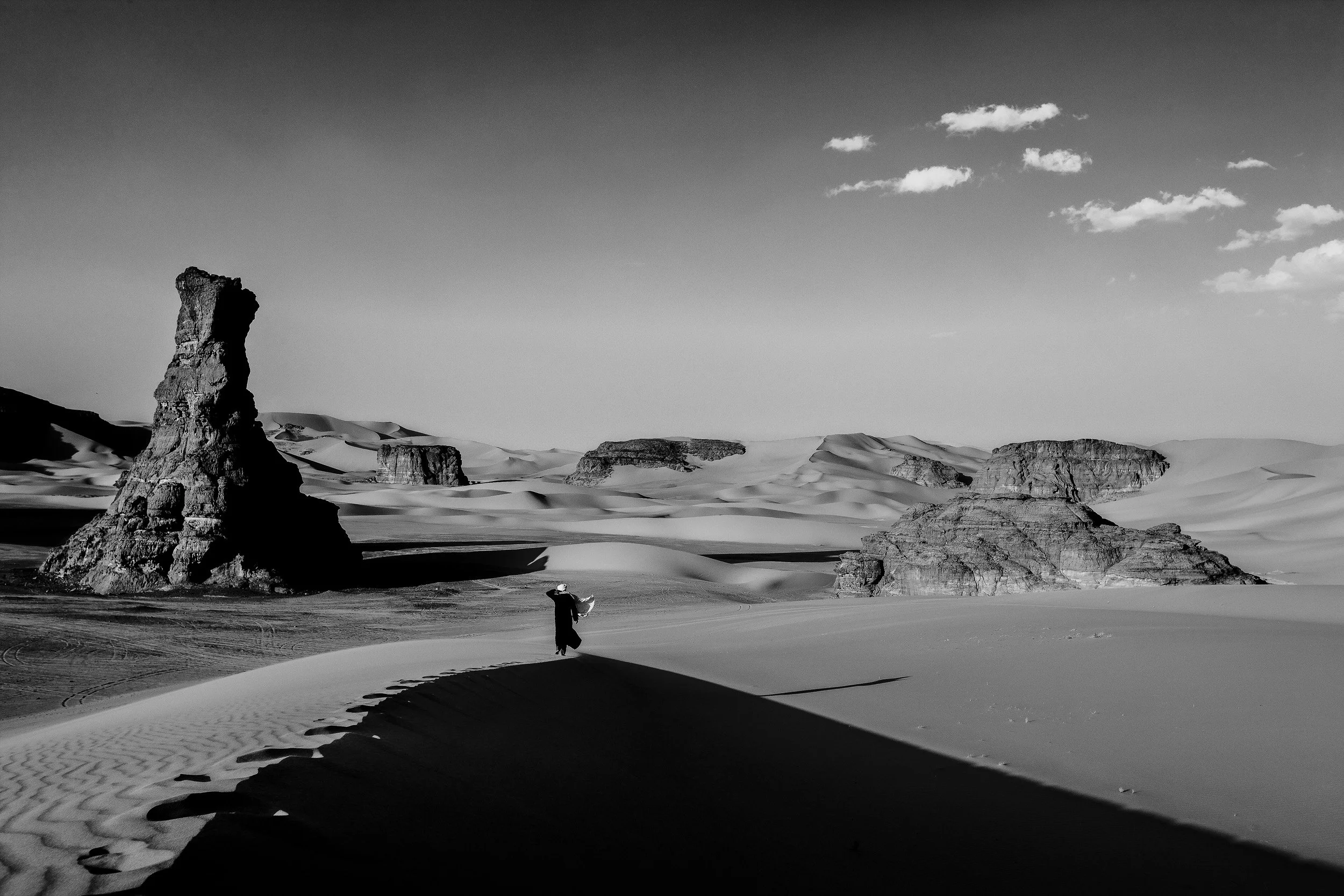
TASSILI 'N AJJER, SOUTHERN ALGERIA: The increasing desertification of the Sahara has driven most nomadic tribes out of the desert and into ever more crowded cities where employment is scarce for unskilled labor, Tassili 'n Ajjer, in the south of Algeria. (photo by Brent Stirton/Reportage by Getty Images.)

TURKANA, KENYA: A Turkana man bathes at the end of the day in Longetch fishing village on the shores of Lake Turkana, Kenya, the world's largest inland desert lake. This region of the lake is at the heart of fishing commerce for the Turkana people. These villagers along with many thousands along the shores of this vast body of water are soley dependent on the lake for their survival. These Turkana are traditionally pastoralists but persistent droughts have decimated their herds to such an extent that for many Turkana fishing is now their main means of subsistence and commerce. The same pattern is emerging for other tribes along the lake shore. Recent dam building in Ethiopia has lowered the Omo river to one fifth of its current flow, this is Lake Turkana's largest tributary. Saudi owned sugar cane farms along the banks of the Omo are already causing tribal movement down to Lake Turkana as pastoralists struggle for grazing and water rights. The Omo river supplies 90% of Lake Turkana's water and these dams and sugar cane farms severely impact the renewal of the lake's waters. This threatens all the tribes around the lake and makes conflict over diminishing resources ever likely. (Photo by Brent Stirton/Reportage by Getty Images for Human Rights Watch.)

LAKE TURKANA, NORTHERN KENYA: A Dasenetch pastoralist father and son use netting to catch Tilapia fish in Lake Turkana in North Kenya. Fishing is a relatively new phenomenon for the Dasenetch, drought and climate change have forced them to look further than cattle for alternative sources of sustenance and economy. Fishing has become the primary means in the Lake Turkana region. The lake is the largest desert lake in the world and sustains both Turkana and Dasenetch people as well as Gabra and other tribes in the region. Lake Turkana faces an uncertain future however as the Gibe 3 dam project in Ethiopia, a massive hydro-electric scheme and Ethiopia's biggest single investment, is now online. The dam project, designed to create electricity for sale to surrounding countries including Kenya, reduced the flow of the Omo river dramatically and this river is the main tributary for Lake Turkana. Significant changes in lake levels and in ecology are the result. Fertile flood plain invaluable for agriculture have been lost. All of this bodes badly for the pastoralists of the Lake Turkana and Omo river region, these groups are already under severe subsistence pressure and there is a long history of armed conflict in the region. Weapons flow in to this region through Sudan and Somalia and there is little control over this trade which looks likely to accelerate as pressures increase in this region. (Photo by Brent Stirton/Reportage by Getty Images.)

TURKANA, KENYA: Boys collect water from a dry river bed to sell it in the nearby town of Karokol, Lake Turkana, Kenya. The water is sold for around 20 Kenyan Shillings for 20 Gallons. The town does not have running water and most water is sourced this way. (Photo by Brent Stirton/Reportage by Getty Images for HRW.)
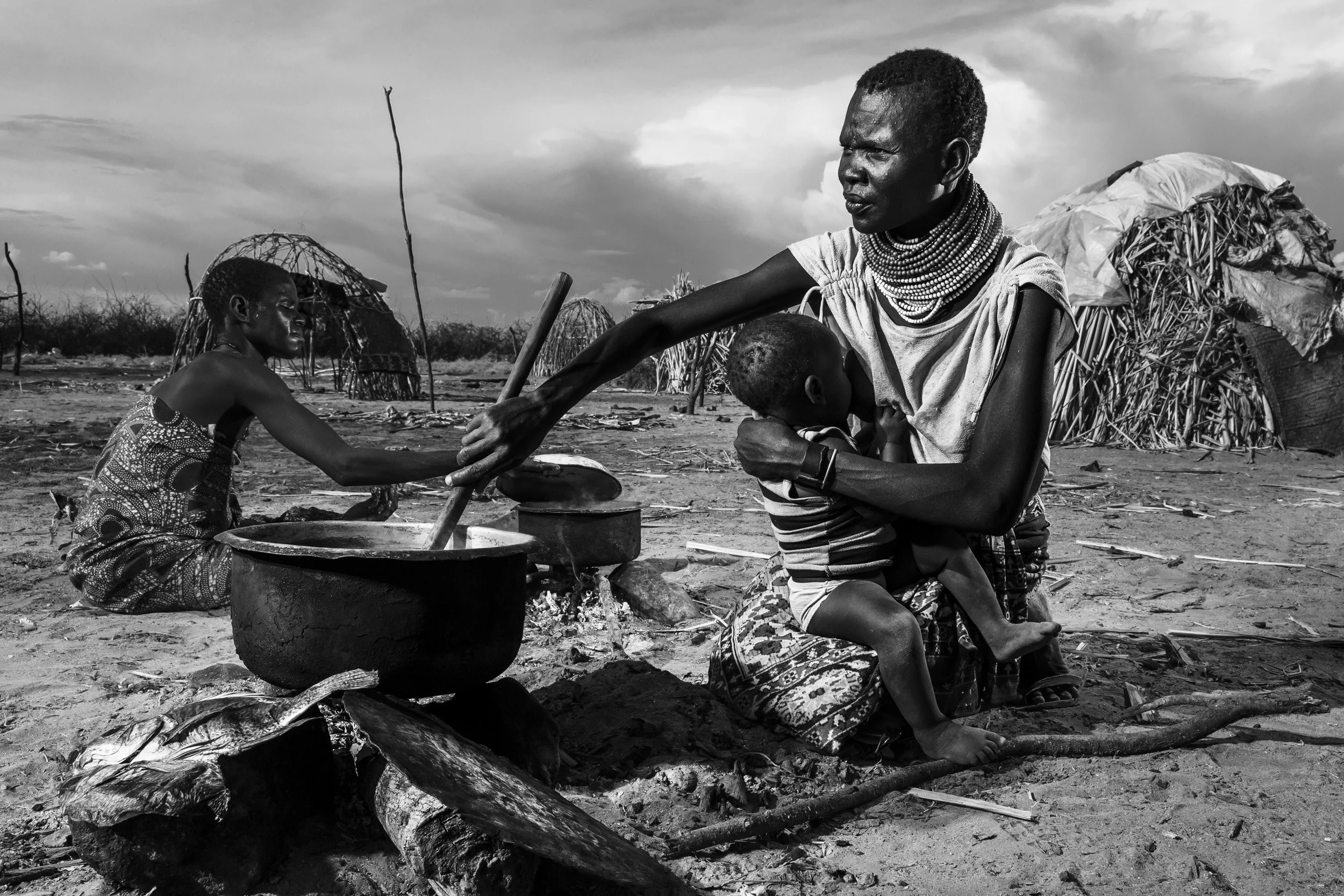
LOWARENGAK, TURKANA, KENYA: Images from an internally displaced Turkana community who have been forced off their land by Dassanech tribesman in a conflict over water and grazing rights, Turkana, Kenya. These Turkana now practise fishing as opposed to their traditional pastoralism as their main means of subsistence. The Dassenech have come illegally over the Ethiopian border into Kenya's Turkana. They were pressured by sugar cane farms on the lower Omo river which is the main tributary for Lake Turkana, the largest desert lake in the world. These sugar cane farms robbed the Dassenech of tradional grazing land and water rights and so they moved over the border into Turkana territory and ongoing conflict is the result. This pattern is increasing as Ethiopia's Gibe 3 dam is in full swing. This has reduced the flow of the Omo river to one fifth of its current size, decimating the fertile flood plain in the region and the tribesmen along the Omo now fight for diminishing resources as a result. This conflict continues in Kenya's Turkana region as all around the lake hundreds of thousands of tribespeople will find themselves competing for less and grazing, fishing and clean water sources. A series of droughts have reduced most of these pastoralists to fishing as their chief source of subsistence due to huge cattle and goat deaths. The massively reduced flow of the Omo, source of 90% of Lake Turkana's water, is having a devastating effect on this food and income source. The Ethiopian government has conducted no Environmental Impact Assessment for their dams and has yet to respond to these issues. (Photo by Brent Stirton/Reportage by Getty Images for HRW.)

LOWARENGAK, TURKANA, KENYA: Images from an internally displaced Turkana community who have been forced off their land by Dassanech tribesman in a conflict over water and grazing rights, Turkana, Kenya. These Turkana now practise fishing as opposed to their traditional pastoralism as their main means of subsistence. The Dassenech have come illegally over the Ethiopian border into Kenya's Turkana. They were pressured by sugar cane farms on the lower Omo river which is the main tributary for Lake Turkana, the largest desert lake in the world. These sugar cane farms robbed the Dassenech of tradional grazing land and water rights and so they moved over the border into Turkana territory and ongoing conflict is the result. This pattern is increasing as Ethiopia's Gibe 3 dam is in full swing. This has reduced the flow of the Omo river to one fifth of its current size, decimating the fertile flood plain in the region and the tribesmen along the Omo now fight for diminishing resources as a result. This conflict continues in Kenya's Turkana region as all around the lake hundreds of thousands of tribespeople will find themselves competing for less and grazing, fishing and clean water sources. A series of droughts have reduced most of these pastoralists to fishing as their chief source of subsistence due to huge cattle and goat deaths. The massively reduced flow of the Omo, source of 90% of Lake Turkana's water, is having a devastating effect on this food and income source. The Ethiopian government has conducted no Environmental Impact Assessment for their dams and has yet to respond to these issues. (Photo by Brent Stirton/Reportage by Getty Images for HRW.)

ENNEDI, CHAD: Nomadic farmers use traditonal wells that have been renovated and deepened by the African Parks organization, a conservation group that want to restore Ennedi to a National Park.

TAZERZEIT, AIR MOUNTAINS, NORTHERN NIGER: M.N.J rebel soldiers bathe at a remote water hole in the Tazerzeit mountains while keeping an eye out for the Niger army forces. M.N.J are a Tuareg-led rebellion against the Niger government for reasons of perceived discrimination and resource ownership by Niger's growing Uranium and Natural Resources industry. The rebellion centers around the loss of traditional water and grazing rights to the extractive industries and the lack of compensation offered. (Photo by Brent Stirton/National Geographic)

TAZERZEIT, AIR MOUNTAINS, NORTHERN NIGER: Images of M.N.J rebel soldiers at a remote water hole, a Tuareg-led rebellion against the Niger government for reasons of perceived discrimination and resource ownership by Niger's growing Uranium and Natural Resources industry. The rebellion centers around the loss of traditional water and grazing rights to the extractive industries and the lack of compensation offered. (Photo by Brent Stirton/National Geographic)
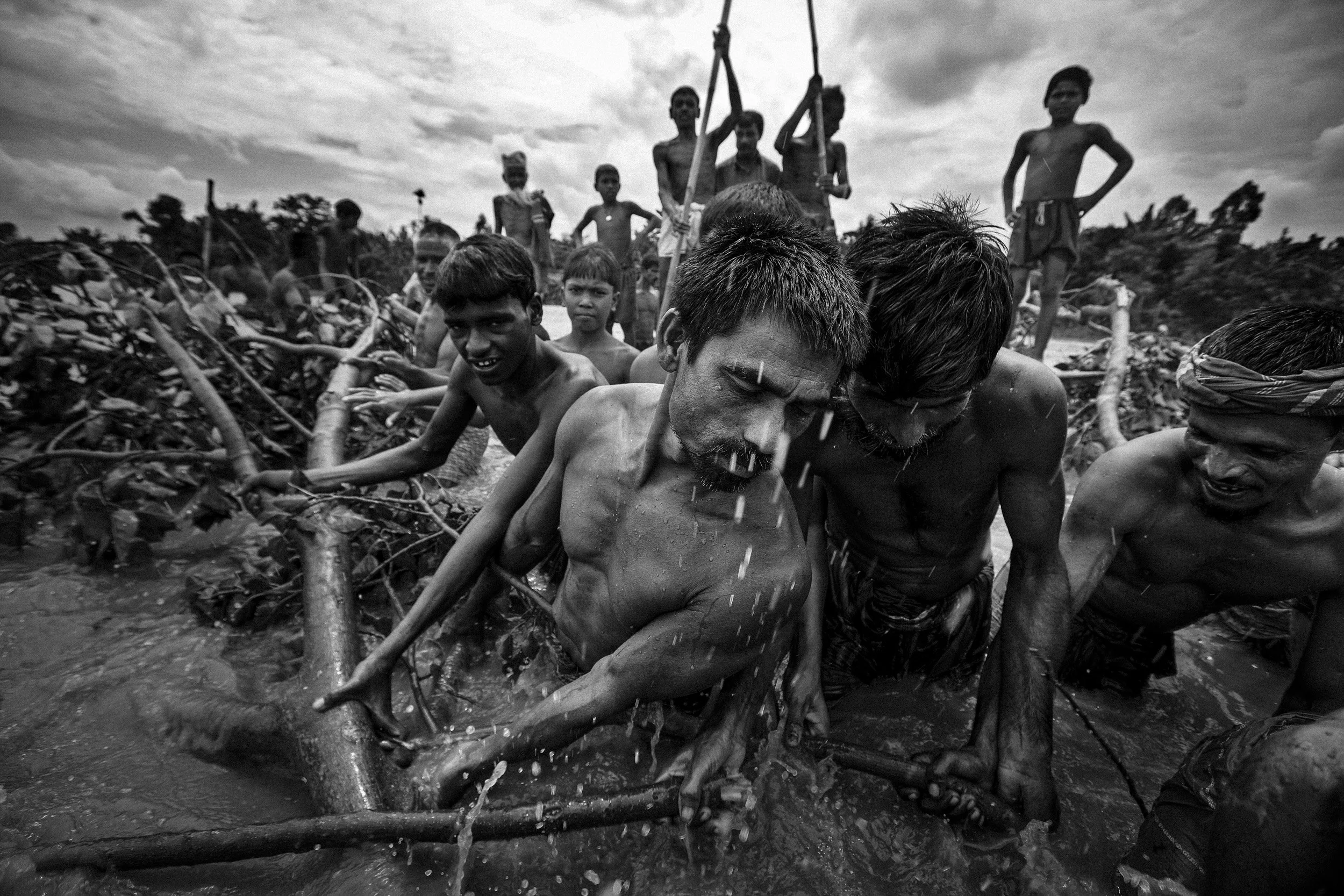
KURIGRAM, BANGLADESH: Village men clear debris from a flooded area so they can use their boats in the area where their village used to be, Kurigram, Northern Bangladesh, 2 August 2008. Flooding, Poverty and lack of protected land ownership amongst the poor is driving a serious food crisis in Bangladesh. A male labourers makes around 90 US cents a day while a women makes around 50 US cents a day working in the fields. Extreme poverty and rising food prices couple with an oversupply of cheap labour has meant that many people can only afford to eat once a day. Many labourers sell their services up to a year ahead and have been caught out by rampant food prices which are beyond the reach of their wages. Bangladesh is one of the worst affected countries in terms of food security. The price of food staples have doubled in the last 5 months and civil unrest is a possibility in the near future. Rising world energy prices, one of the world's poorest populations, and a loss of government subsidies for food staples combined with the world's highest flood plain has meant that many people are down to one meal a day. (Photo by Brent Stirton/Reportage by Getty Images.)
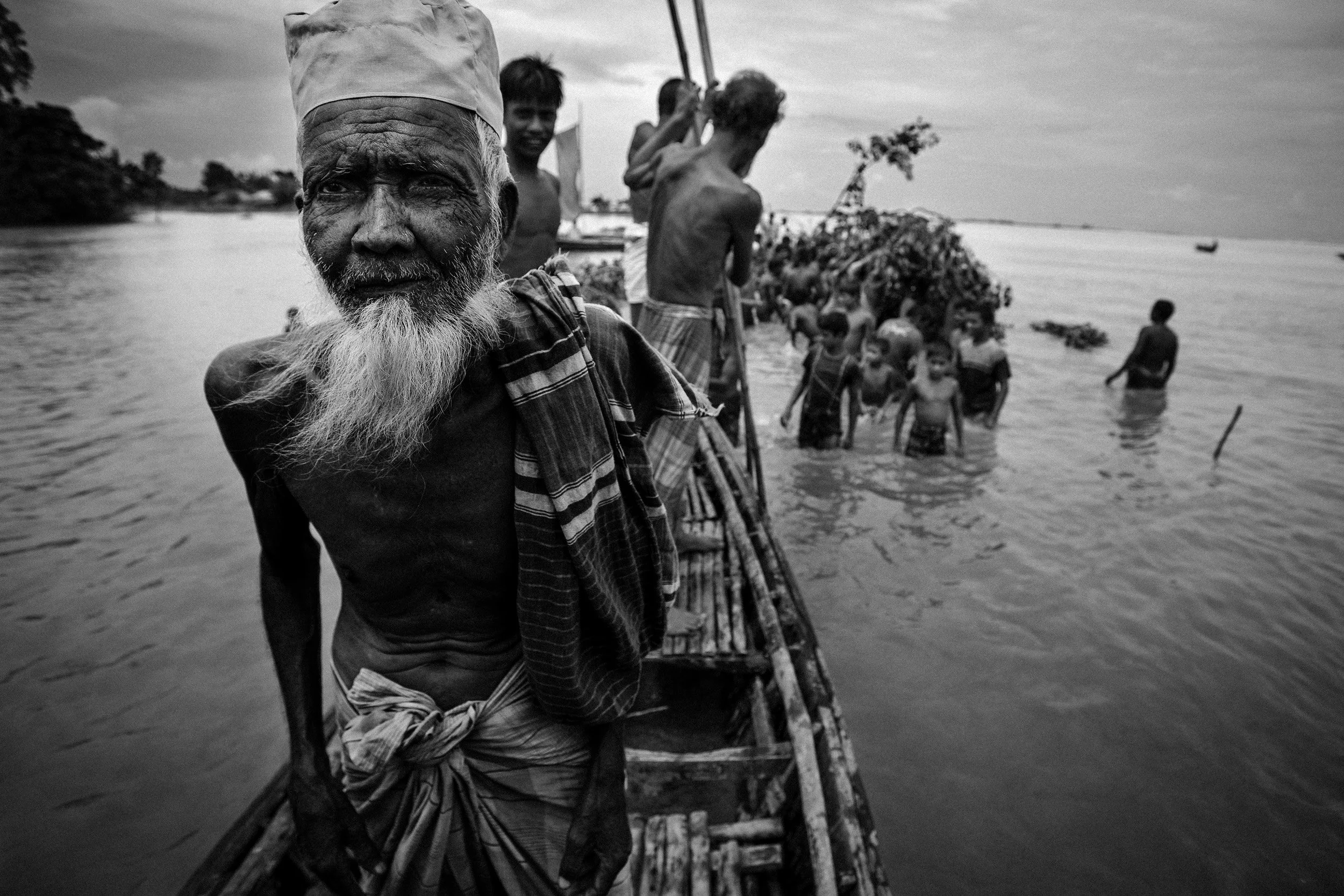
KURIGRAM, BANGLADESH: Evacuating villagers from a flooded area where their homes have been destroyed. Annual flooding and a lack of logistical planning around it present a crisis in Bangladesh affecting millions of the poor. (Photo by Brent Stirton/Getty Images.)

KURIGRAM, BANGLADESH: Flood displaced women seen in a temporary refugee camp. Annual flooding and a lack of logistical planning around it present a crisis in Bangladesh affecting millions of the poor. (Photo by Brent Stirton/Getty Images.)

TIMBUKTU, MALI: Children play in the rain after flash floods in a respite from the desert heat in a street scene in Timbuktu, a historical Malian city. These floods are a recent development in this desert town and are thought to be as a result of climate change. (Photo by Brent Stirton/Reportage by Getty Images.)

OK TEDI, NORTHERN PAPUA NEW GUINEA: Village children swim in a tailings dam close to the failed Ok Tedi mine in Papau New Guinea. This mine's huge tailings dam failed and flooded into the Ok Tedi river, contaminating the water source for hundreds of miles and destroying traditional hunting areas as animals moved out of the area. Local people continue to live in the area but disease related to the contaminated river is common.

PORGERA, PAPUA NEW GUINEA HIGHLANDS: An impoverished Papuan family illegally prospects in a mine tailings river with heavy metal laden waters on the outskirts of the Porgera Joint Venture Mine, Papua New Guinea. These empoverished people engage in illegal mining on the dumps and tailings outflow areas of the mine in order to survive. They take their five year old daughter and their 7 year old son with them on their daily mining excercises, child workers are a common site on these dumps which are both toxic and a highly dangerous illegal environment. Many of these local people sold their land to the mine for a period of the operational life of the mine. They underestimated how long the mine would keep going and the expansion thereof. The Mine dumps now flow onto the last viable land of these local people and they illegally mine those dumps to eke out a living. The ability to grow vegetable gardens is very limited and there is no hunting anymore. There are regular clashes between these illegal miners and the Porgera Joint Venture mine security force. Close to the mine the waters are red from these tailings and it is feared that long term damage of the river system is inevitable. (Photo by Brent Stirton/Reportage for Human Rights Watch.)
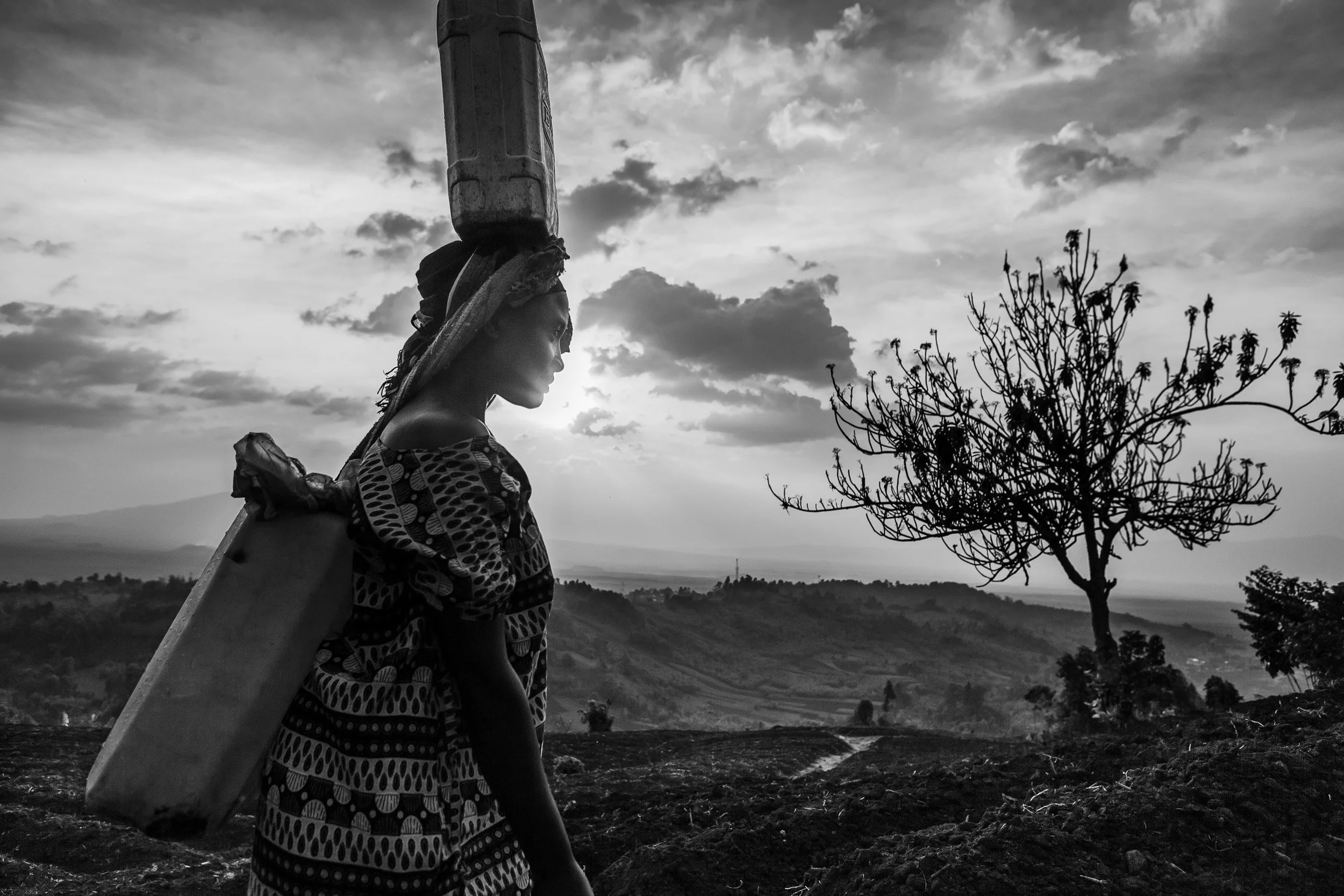
RUMANGABO, EASTERN DEMOCRATIC REPUBLIC OF CONGO: Women and children fetch water from a newly contructed tap system built by the ICCN Congolese Conservation authority on the outskirts of Virunga National Park, DRC. This facility means the women and children no longer have to walk 6 kilometers to springs higher on the mountain. This has improved productivity, water quality and safety for the women. In addition to this project ICCN has constructed more than 30 schools, water points and hydro-elecric schemes, all part of a concerted effort to building understanding and appreciation for the park in the minds of local communities. (Photo by Brent Stirton/Reportage for Getty Images.)
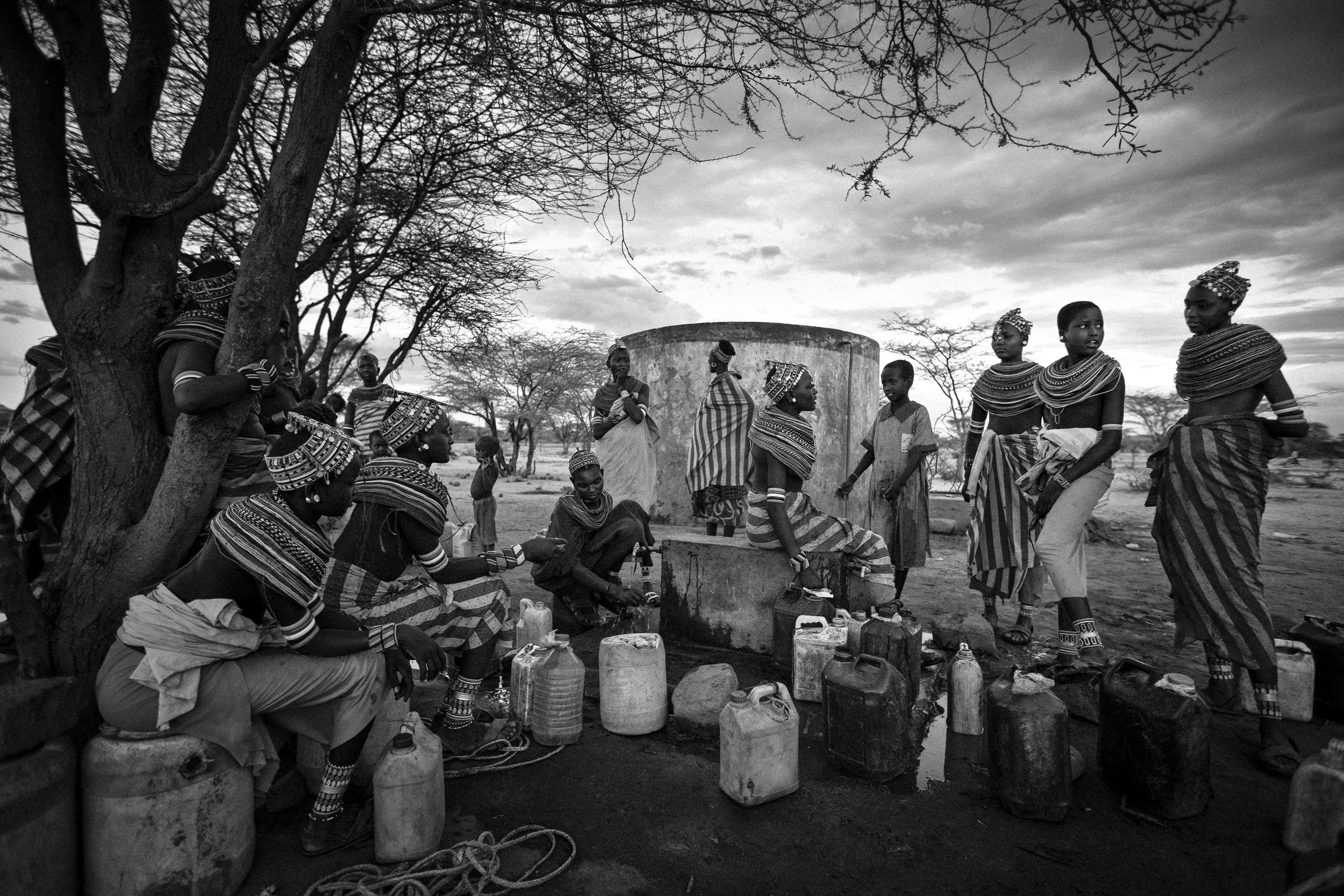
LAISAMIS, MARSABIT SOUTH, NORTH KENYA: Rendille women collect water from a well at the new Manyata Koya, a relocated village which moved 42 kilometers from the original Koya in 1992 due to heavy cattle raiding and fighting with the Borana tribe, North of Kenya, 27 February 2010. The collection of water remains the responsibility of women in most rural communities. The time this takes on a daily basis prevents them from ever fullfilling their potential. A great deal of the fighting for cattle and grazing rights in the region can be linked to the droughts in the region and the pressure that has placed on pastoralists. (Photo by Brent Stirton/ Reportage by Getty Images.)

KALOKOL, TURKANA, KENYA: Girls from Kalokol Girls Primary school collect water from a dry river bed as their school does do not have access to running water. The girls take it in turns to fetch water daily from a dry river source which sees them exposed to potential danger and taking time off from their studies to walk the two hour round trip it takes them to fetch water. (Photo by Brent Stirton/Reportage by Getty Images for HRW. )

TURKANA, KENYA, 8 OCTOBER 2014: Women from Longetch fishing village fetch water on the shores of Lake Turkana, Kenya, the world's largest inland desert lake. This region of the lake is a well know spawning ground and at the heart of fishing commerce for the Turkana. These villagers along with many thousands along the shores of this vast body of water are soley dependent on the lake for their survival. The Turkana are traditionally pastoralists but persistent droughts have decimated their herds to such an extent that for many Turkana fishing is now their main means of subsistence and commerce. The same pattern is emerging for other tribes along the lake shore. Recent dam building in Ethiopia is likely to bring the Omo river to one fifth of its current flow, sugar cane farms along the Omo are already causing tribal movement down to Lake Turkana as pastoralists struggle for grazing and water rights. The Omo river supplies 90% of Lake Turkana's water and these dams and sugar cane farms look likely to severly impact the renewal of the lake's waters. This threatens all the tribes around the lake and makes conflict over diminishing resources ever likely. (Photo by Brent Stirton/Reportage by Getty Images for Human Rights Watch.)

Rural Kenya: Two woman fetch water using donkeys miles from their village, they make this trip at least once a day seven days a week. It takes a large part of the day and prevents women from other forms of employment, ongoing education and real participation in village life. Water is a gender issue, with women at the forefront across the majority world. As long as women have to deal with this burden they can never reach their full potential.

Rural Kenya: Schoolgirls fetch water to take to school, their school has no running water facility. Water collection takes a large part of the day and often prevents women from other forms of employment, ongoing education and real participation in village life. Water is a gender issue, with women at the forefront across the majority world. As long as women have to deal with this burden they can never reach their full potential.

MIDRAND, SOUTH AFRICA: Students queue up for water at their new taps at a Midrand school in South Africa. These taps have been made possible by corporate sponsorship of local NGO's. Access to clean water for drinking purposes and for toilets increases school attendence worldwide and improves the health of students. It also dramatically increases the attendence of girls who are experiencing their period once a month to have a proper toilet facility at school. (Photo by Brent Stirton/Reportage by Getty Images.)

KISUMU, KENYA: Boys at a high school in rural Kenya queue up with water containers to receive water from their schools new water tank, Kisumu, Kenya. Access to a regular and clean water source makes for a far less disruptive school experience for students, grades improve and there is far less sickness to disrupt their studies. (Photo by Brent Stirton/Reportage by Getty Images.)

KWAZULU, NATAL, SOUTH AFRICA: A young boy in a rural area bathes in the evening. Millions of people around the world use rivers and water holes for their daily hygeine and water needs. Protection of these sources is vital for the people.

KASUNGO, MALAWI: A rural village has taken its water and food security a step further by building a dam for rainwater and then using footpumps and watering cans to get the water to fields to grow maize, Kasungo, Malawi. (photo by Brent Stirton/Reportage by Getty Images.)

MEGMA, NEPAL: An old Nepali women fetches water from a reservoir created by harvesting the water vapour contained in fog high in the mountains of Nepal near the Indian border, Megma, Nepal. The fog passes through a netting system on the mountain top. Upon contact it condenses into water vapour droplets. Gravity leads it down the net and into pipes which channel it to the village water tank. As a result of the system there is now sufficent water for a school in the village and the local children no longer have to leave for their education. (Photo by Brent Stirton/Reportage by Getty Images.)

FIJI: An 83 year old man stands in the waters off his traditional village inamongst the gravestones of his ancestors. When he was a boy the gravestones stood on dry ground. It is believed that global warming is responsible for the rise in water levels in this region.

Maldives: Fishermen in the Maldives raises an empty net, they say that this used to be an abundant fishing area but global warming has killed many reefs in the Maldives and the waters now yield very little fish. This forces fisherman to travel much further to fish.
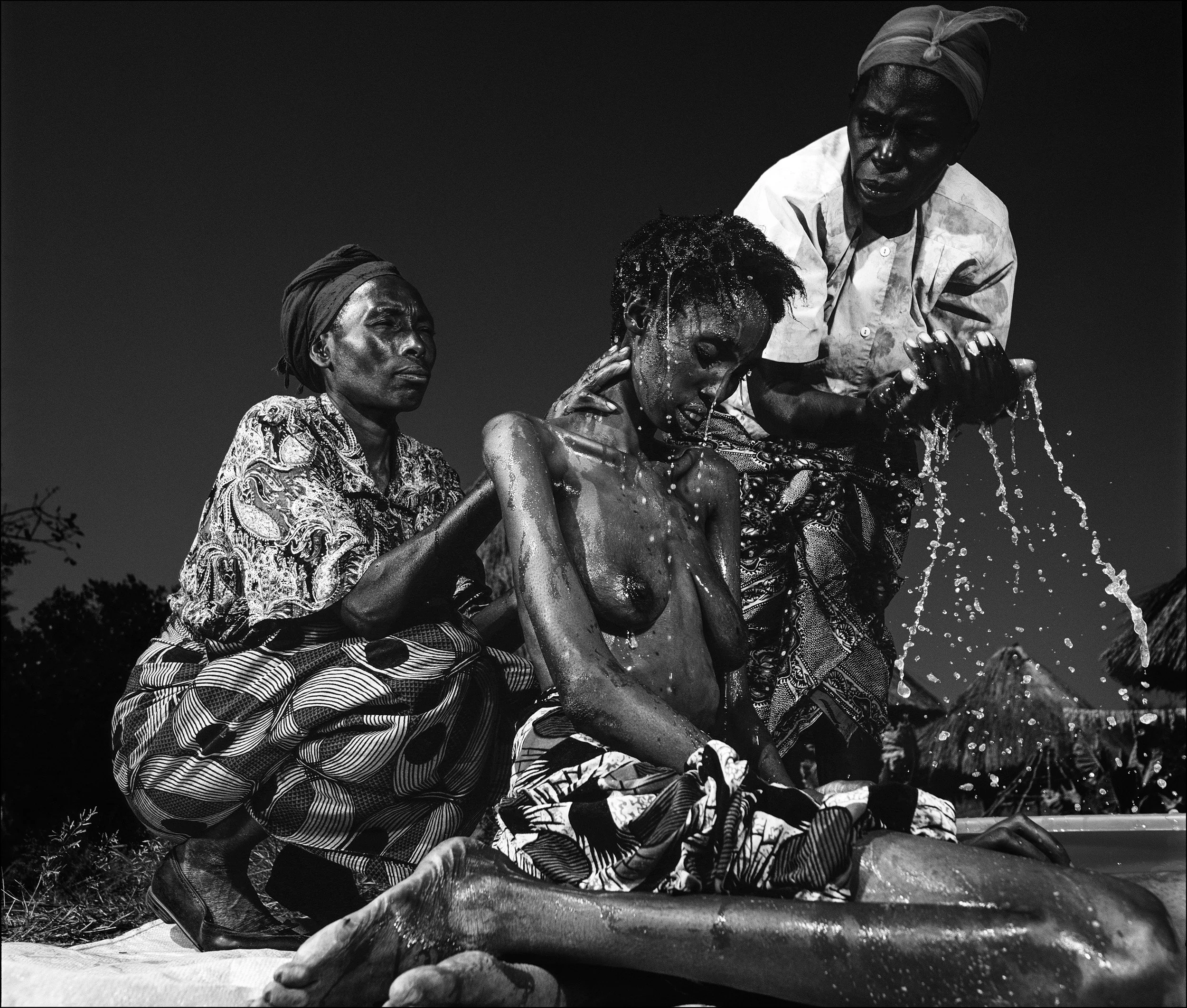
Zambia: A mother bathes her daughter who is dying from full-blown AIDS. Access to clean water is often difficult in remote parts of rural Africa and people living with HIV and other immuno-suppresant disease die more quickly as a result.
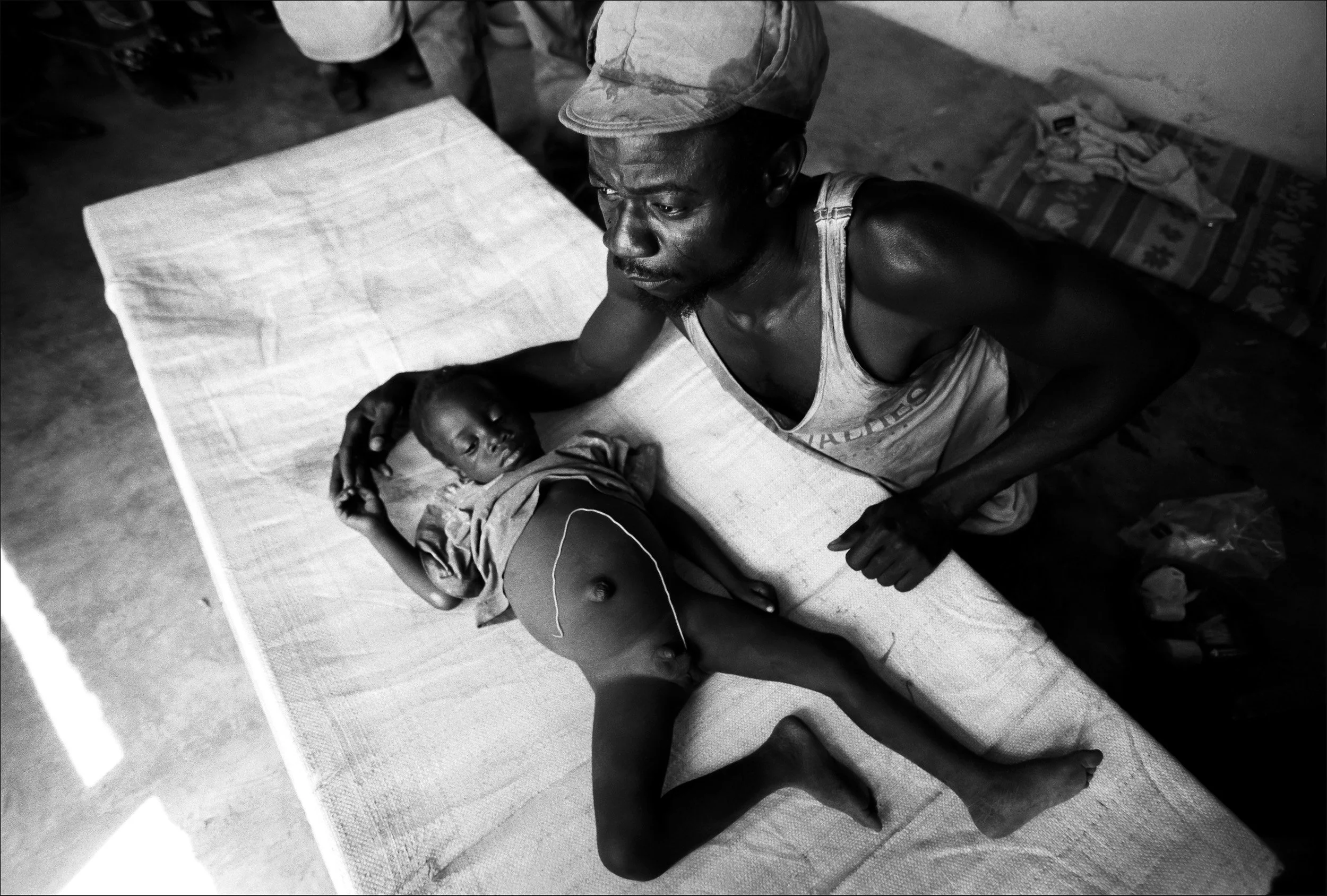
NORTH GHANA: A worried father watches over his son as a guinea worm is removed in stages from the boys testicles. Guinea worm is a parasite which lives in water holes in certain African countries. There is no other water source for these people and when they drink the infected water they ingest the parasite. After an 18 month gestation period the worm emerges as an infected cyst, cripplingly painful and can incapacitate its victim for months. The worm is removed slowly, often over a period of days. The body of the worm is wrapped around a stick and drawn slowly out so as not to snap the creature in half leaving the dying parasite inside the person. The people in these regions have no other water source and so are forced to go through this process many times. (PHOTO BY BRENT STIRTON/REPORTAGE BY GETTY IMAGES.)

Tanzania: An 18 year old women in the final stages of pregnancy fights off a bout of Malaria at a rural clinic. Pregnant women who contract the disease pass it onto the child, significantly reducing the child's chances for survival. Malaria remains one of the world biggest killers, with a direct link to mosquito habitats in areas of stagnant water, often the only water source available to people in rural Africa.

Buchanan, Liberia: A young refugee child suffering from Cholera is examined at a make-shift rural clinic. At this time around 20 people a day were dieing from this infectious disease in the refugee camps. Cholera is common to refugee camps as overcrowding leads to pollution of the water source by human waste and no facilities exist for alternative water sources.

SOUTHERN SRI LANKA-NOVEMBER: A Tsunami survivor cries in the ruins of the house she used to share with her husband and two children. They were lost in the wave and she now lives in the ruins of the house trying to work out how to reclaim some part of her life. Photo by Brent Stirton/Getty Images

MAZUCO, PERU-JUNE: Images of the ongoing construction of the Inter-Oceanica highway, Mazuco, Peru. The building of the Inter-Oceanica Highway road has had many effects on Peru. One of the major effects is the diverting of water sources, rivers and dams. One of the longest, most ambitious road projects in the world, it crosses Peru through the Amazon rain forest regions and continues through the Andes into Brazil. It provides the potential for great economic growth for Peru through improved transportation routes which ease the need for imports in Peru. The road however threatens the fragile eco-systems through which it passes, and that threatens much of the sustainable, subsistence existence of many Peruvians. (Photo by Brent Stirton/Reportage by Getty Images.)

MANHATTAN, NEW YORK: A worker sweeps out the final stage of the 3rd water tunnel for New York City. The Tunnel has been built to allow for maintenance of the 2 existing but aging tunnels. The third tunnel is also far more secure and is a response to the possibility of a terror threat to the water system of the city. (Photo by Brent Stirton/Reportage by Getty Images.)
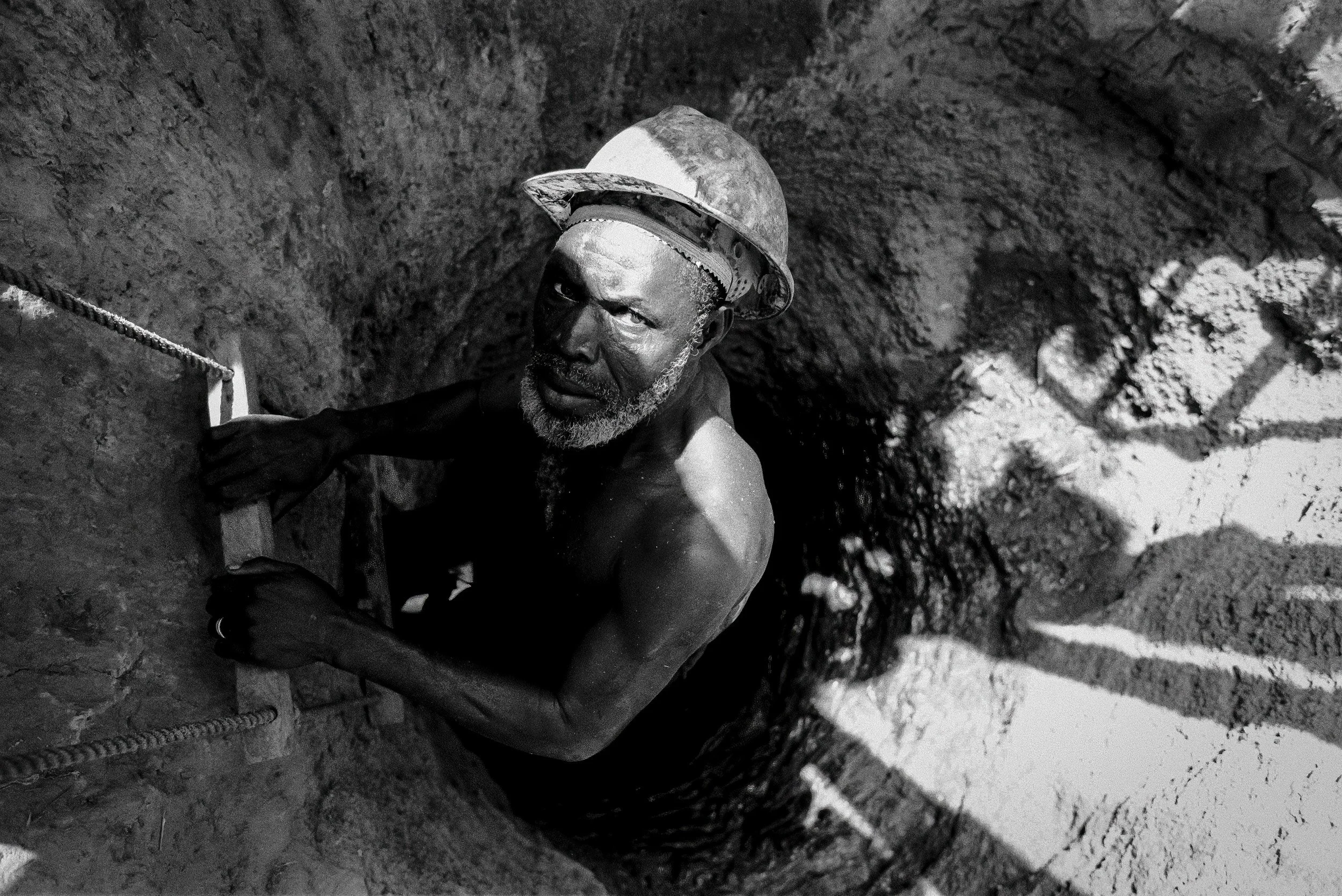
BOLGATANGA, GHANA: A man tunnels for water in a rural village where the locals have to dig further and further into the ground to access the retreating aquifer. (Photo by Brent Stirton/Reportage by Getty Images.)
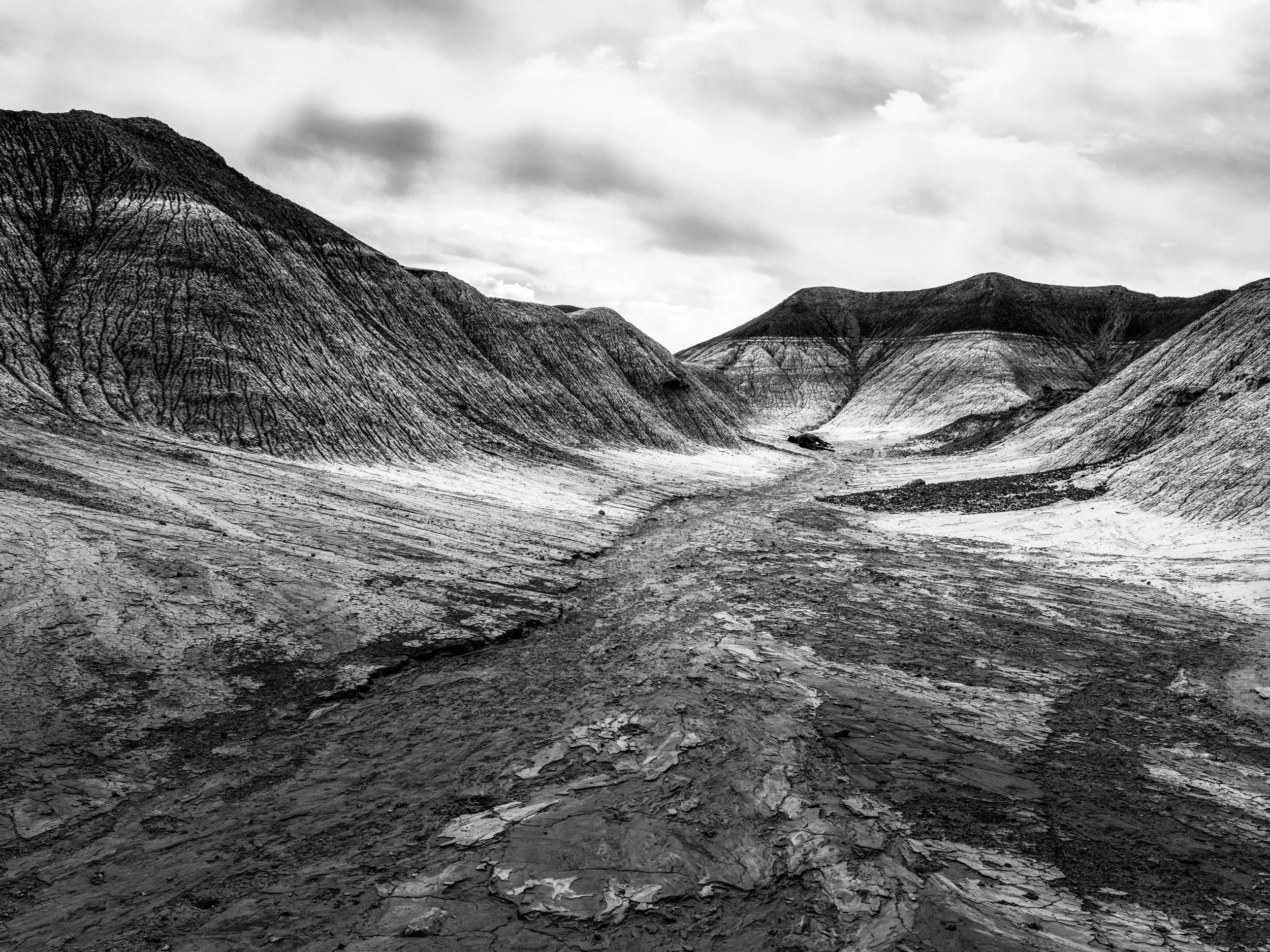
CAMERON, ARIZONA: A dead wild horse lies mysteriously at the end of a small canyon in the badlands of Cameron, Arizona. This is an area of extensive uranium mining, these mines have poisoned water sources in many parts of the reservation and the Navajo Nation has never been fully compensated for the damage to their way of life. (Photo by Brent Stirton/Reportage for Le Figaro Magazine.)
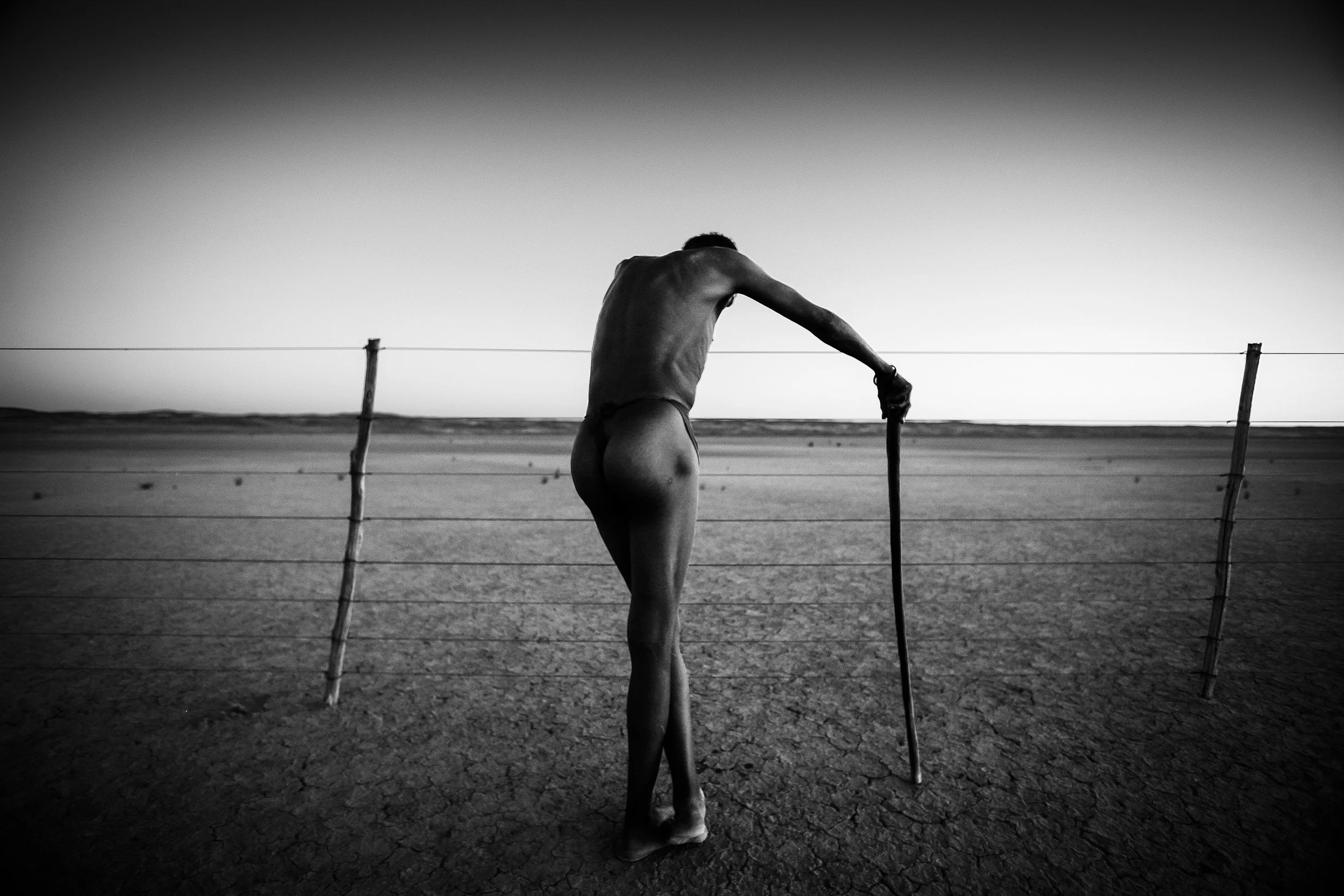
KALAHARI DESERT, SOUTH AFRICA: A San Bushman elder rests on a fence in the Kalahari desert that divides what used to be traditional bushmen land and is now mining territory. The San community says that access to water holes and traditional hunting are no longer possible for the bushmen who now lives lives on societies margins. (Photograph by Brent Stirton/Reportage by Getty Images.)
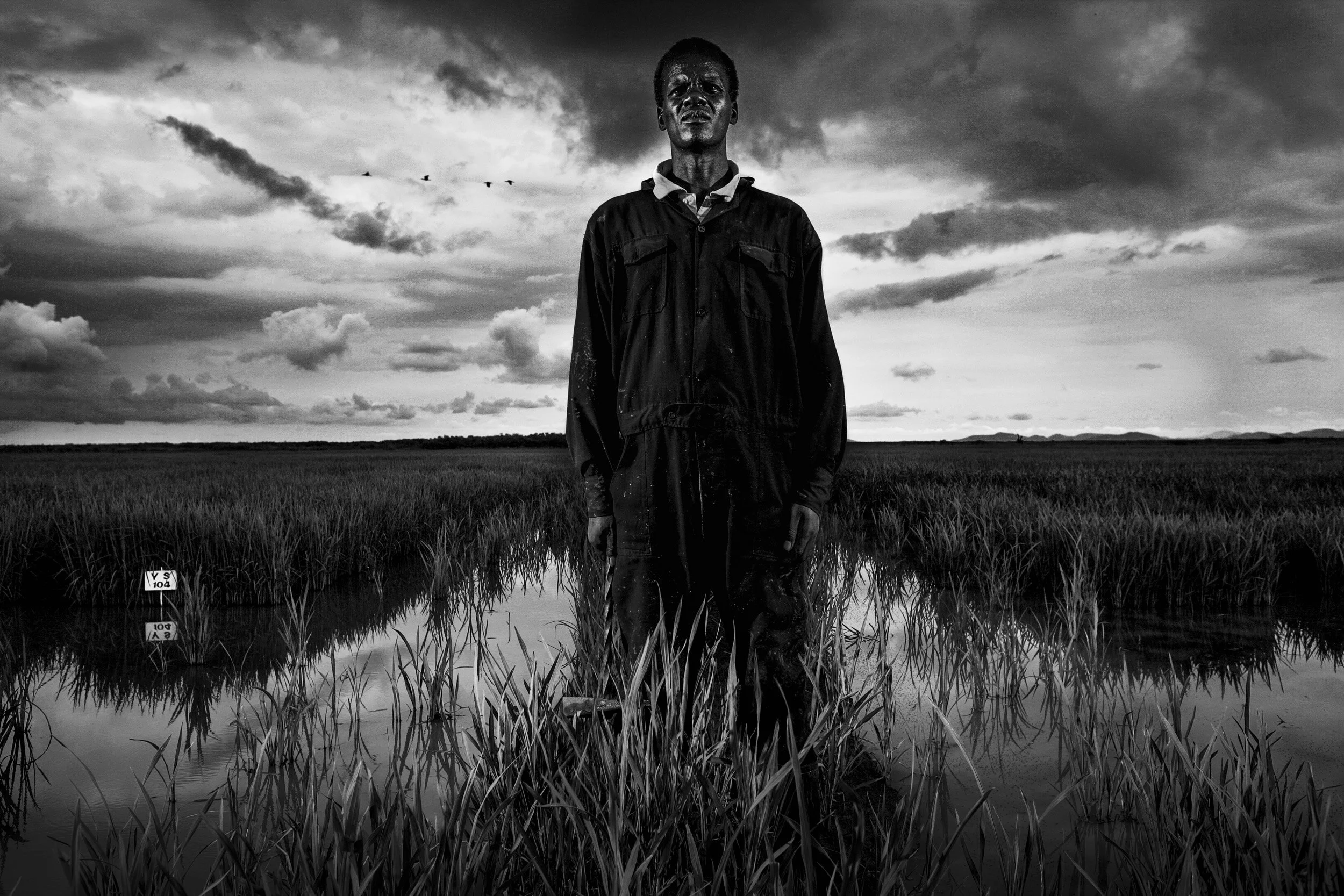
BUNGOMA, KENYA : Images of a laborer in the rice-fields of Dominion Farm, the largest private American investment in in Kenya. The farm specialises in fish breeding and massive rice production and as a result has disrupted water availability for the local population. Large scale farming in Africa frequently does not consider local water usage.

KIBERA SLUM, NAIROBI, KENYA: Men pour raw sewerage into a polluted stream in Kibera slum, Nairobi. Urban drift now means that in the last 5 years more people live in cities than in rural areas worldwide. Many of these people are unskilled and crowded into slums without adequate clean water access. There is little viable sewerage disposal or adequate hygience facility. As a result the outbreak of disease is common and traditional water supply for cities is increasingly under threat from these slum communities. (Photo by Brent Stirton/Reportage by Getty Images.)

MUTWANGA, NORTH KIVU, DEMOCRATIC REPUBLIC OF CONGO: Kaseraka, 28, a polio victim, sweeps stones away from the main water flow area on a Congolese Conservation authority Virunga Hydro-electric project in Mutwanga, DRC. Kaseraka is in charge of maintenance for the project and is typical of the disadvantaged community this scheme will benefit. This hydro-electric scheme is the Park's largest community project and will provide electricity to an empoverished community of 25 000 people as well as to schools, a general hospital and an orphanage. The pay off for the park is that the community comes to understand the relationship between healthy forests and healthy water supply as well as vastly improved community relations. Electricity will also be available for industry and that could revolutionise the community, allowing for the retention of the value of Congolese products internally as opposed to constant and expensive imports. (Photo by Brent Stirton/Reportage for Geo Magazine.)

IMPERIAL VALLEY, CALIFORNIA: The All American Canal, the main water conduit from the Colorado River into the Imperial Dam, Imperial Valley. The Imperial Valley is a desert area which controversially uses three quarters of Californias allocated river water for agricultural purposes. The agricultural techniques have traditionally been flood and furrow which experts claim waste vast quanties of precious water. Imperial Valley farmers are looking at alternative techniques through which to conserve water supply. (Photo by Brent Stirton/Reportage for Getty Images.)

IMPERIAL VALLEY, CALIFORNIA, AUGUST 2009: Mexican workers in the Imperial Valley, an agricultural area which traditionally uses water from the Colorado river distributed through a series of canals and irrigation channels, Imperial Valley. The Imperial Valley is a desert area which controversially uses three quarters of Californias allocated river water for agricultural purposes. The agricultural techniques have traditionally been flood and furrow which experts claim waste vast quanties of precious water. Imperial Valley farmers are looking at alternative techniques through which to conserve water supply. (Photo by Brent Stirton/Reportage for Getty Images.)

THE SALTON SEA, CALIFORNIA: A tranquill scene from the Salton Sea, a dying inland lake which currently exists as a result of run off agricultural waste water from the fields of Imperial Valley and the Coachella Valley. The Salton Sea is 25% more saline than the Pacific but remains an important wetland for migrating birds and agriculture in the region. A former resort area, its is economically depressed nowadays and all reports seem to indicate a drying out of the sea as greater efforts move into place to conserve water on the surrounding farmlands. There are genuine concerns that the drying out of the Salton sea could lead to a dustbowl situation in which years of accumulated fertlizers, salts and pesticides which are in the Salton sea could be released into the air. (Photo by Brent Stirton/Reportage by Getty Images.)

NAVAJO NATIONAL PARK, ARIZONA: Wayne Wilson and his son Shelvin bring water and food to very vulnerable people without transport all over the Navajo reservation. Many parts of the reservation don’t have access to water where they live so Wayne tries to service the most vulnerable families in those areas. He created a small Gofundme page and secured the service of a donor vehicle and water tank. He also donates water barrels and food if needed. So far he has helped over 100 families and drives an average of 400 miles every time he does a delivery. Several million people across the USA do not have access to running water, the Navajo Nation is just one place where this occurs.
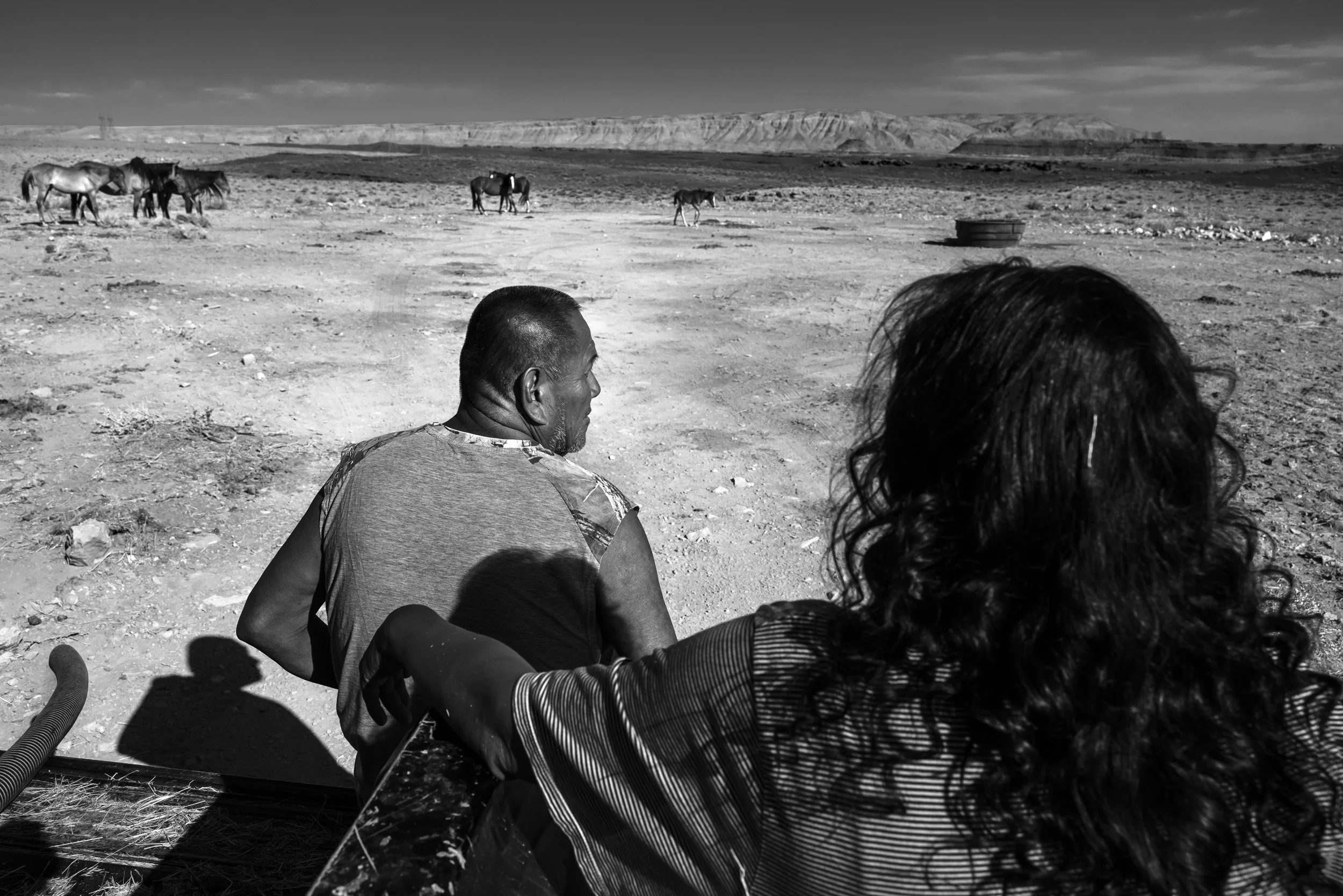
GRAY MOUNTAIN, ARIZONA: Gray Mountain Horse Rescue is a Navajo organization that attempts to safeguard wild horses and provide them with adequate drinking water which they truck out to areas where there is little water access.
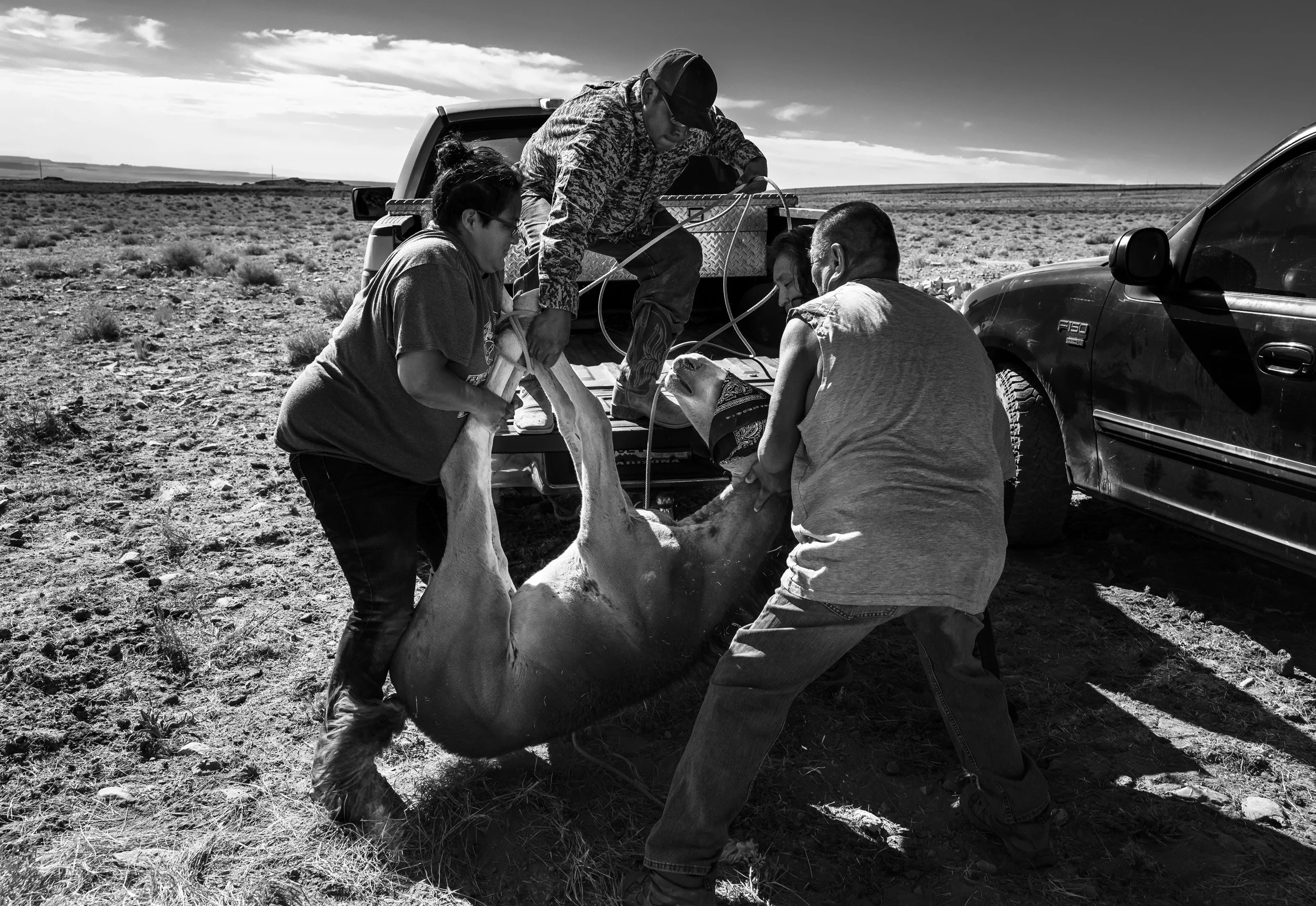
GRAY MOUNTAIN, ARIZONA: Gray Mountain Horse Rescue is an organization that attempts to safeguard wild horses across the Navajo Nation. Part of their mission is to provide these wild horses with adequate drinking water which they truck out to areas where there is little water access. They are seen moving a young foal to an area where there will be better water access and grazing. It would be likely to die otherwise.

VARANASSI, INDIA: A feral dog consumes a body buried in the Ganges in the holy city of Varanassi, India. The Ganges River in India is considered a holy river for many devotees, bathing in it on a regular basis is regarded as a form of cleansing for the spirit and the body. (Photo by Brent Stirton/Reportage by Getty Images.
